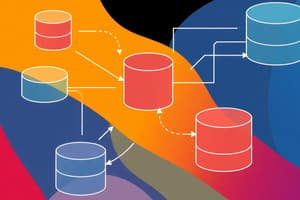Podcast
Questions and Answers
Find the incorrect statement about a 1:N relationship in a data model
Find the incorrect statement about a 1:N relationship in a data model
- It implies the presence of more than one case table (correct)
- It means that Table 1 can have multiple records for each record in Table 2
- It represents that there are n elements in table 2 for every one element in table 1
- The tables are associated with each other by mapping keys
What does a 1:N relationship represent in a data model?
What does a 1:N relationship represent in a data model?
- There is one element in table 2 for every n elements in table 1
- There are n elements in table 1 for every one element in table 2
- There are n elements in table 2 for every one element in table 1 (correct)
- There is one element in table 1 for every n elements in table 2
How are tables associated in a 1:N relationship in a data model?
How are tables associated in a 1:N relationship in a data model?
- By cross-referencing indexes
- By mapping keys (correct)
- By duplicating records
- By overlapping data
Flashcards are hidden until you start studying
Study Notes
1:N Relationships in Data Models
- Represent a relationship between one parent entity and multiple child entities
- One parent record in one table can be associated with multiple records in another table
- Used to model relationships where one entity has multiple instances of another entity
- Tables are associated through a foreign key in the child table that references the primary key in the parent table
Studying That Suits You
Use AI to generate personalized quizzes and flashcards to suit your learning preferences.




